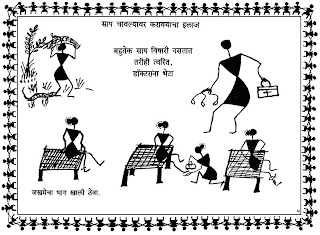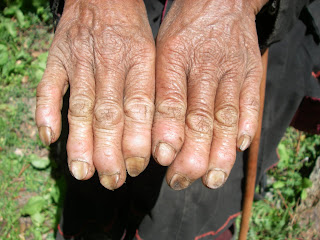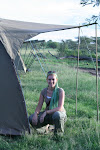Saturday ended the same way it began: with death.
I left for Mumbai on Thursday, intending to spend the Rosh Hashanah weekend in the city, shopping and eating pastries. Instead, I went back to Palghar early Friday morning when Shashi, who was watching Moti while I was away, phoned to say that he seemed very sick. Coming home, I found a lethargic puppy with deep, sad eyes; he had refused to drink or eat anything for the past day. I ran around frantically, trying to find a veterinarian. You might think that this is a relatively easy task, considering all of the dogs and various livestock wandering the streets; you might think that, and you would be wrong. This being India, nothing is impossible, but almost everything is incredibly difficult. I searched online, called everyone I knew, went out on foot in the blistering sun; I begged, pleaded, offered money, then more money; I cursed unintelligible Marathi signs and indifferent fruit vendors. Finally, with help from Impact, I found a vet who arrived with a dingy metal medical bag three and a half hours late. In the interim, Moti had had two episodes of bloody diarrhea; dark, maroon blood, the kind that soaks deep into your consciousness and makes your heart beat faster. Moti didn't go on the floor; he was so intelligent and so dignified that even at his weakest, he made the effort to walk outside the apartment and emptied his bowels on my neighbor's welcome mat. He then teetered back to me and lay his small furry head in my lap.
The veterinarian smiled at me and gave the dog two shots of antibiotics. I told him, anger mixed with exhaustion, that I'm a doctor, demanding to know what he was giving him and what he thought was wrong. In India, as in Russia, doctors don't feel a need to inform their patients, or the patients' relatives, of what's happening; they are the "experts" and we should be happy to defer to their judgement. I certainly wasn't happy, and was getting less so by the minute; I got a prescription for some ayruvedic medicine and oral ciprofloxacin, which Moti would later vomit all over the floor. I stayed up with him all evening and half the night, forcing him to drink rehydration solution through a pipette and reasurring him with gentle petting. He lay calmly on my lap, looking up at me occasionally. Sashi thought he looked better; I thought his eyes were tired, resigned. I let him sleep in my bed, neatly curled up in a ball. At some point, in the middle of the night, he got up to vomit again nearby and stumbled out of my room. I found him, early in the morning, peacefully asleep on the kitchen floor, his body rigid and soul-less. We buried him in an empty, grassy field near Impact's office. I buried him with his blanket and a small Star of David I found in my jewelery bag. I threw dirt on his grave until my vision was blurry and my throat was raw.
I cried all afternoon, and then took the train back to Mumbai in an effort to escape the emptiness, even for a little while.
Crushed in a muggy train car, pale yellow walls peeling into rust, dusty, dead fans hanging overhead, I can barely move, barely breathe. We are not people, we do not have personalities or identities; we are just bodies, pushed together, until the only available space is outside the train, and even there other bodies are hanging on. I'm trapped between a young woman in a brightly decorated red sari and a peculiarly large, black plastic suitcase. I am soaked, I cannot feel my feet, I'm dizzy and hot and oh-my-god-i-have-to-get-out-now-please-now!! I think I am delirious, I'm daydreaming that the woman is a spy and the black suitcase contains nuclear weapons, that the crippled beggars are just actors and the baby crying next to me will stop sometime. I manage to pull a bottle of water from my bag and take a sip; it's hot, it tastes like stale biscuits, it tastes like India. An elderly woman on a bench across from me gazes at the water with familiar, resigned eyes; I give her the bottle and am resigned myself.
I'm angry and exhausted. India killed Moti, and it's killing me. The suffering is overwhelming, and I cannot be shielded from it; I have thrown myself in, deeply, and I cannot get out. I feel like i'm drowning in the enormity of what's around me; every beggar, every dirty child, every cripple, stray dog, every cracked street corner reminds me that I did not save Moti because I could not save him, because we are in India and in India we all die a little every day. I cannot give money to every dusty child, but even if I could, I cannot feed them, clothe them, and love them. I cannot offer a home to every puppy or grass to every cow; I cannot, and the government does not, and it's killing me. I'm not sitting in an air conditioned room reading the newspaper; I'm in the field, I'm involved, and still, perhaps more so, I am complicit to the suffering. I thought that it was difficult to look at disasters and suffering from afar, to study abstract scientific principles while people suffered and died from very concrete diseases. It is even more difficult being here, emtpy-handed no matter how much i'm holding.
I went to dinner with Neelam and her friends on Saturday. They discussed the NGO, its' future directions. Neelam wants every Adivasi village to have a computer so that they can record their immunization records and other health data. One of her friends, a leader and community organizer within Mumbai's slums, argues that computers only encourage inaccuracy, that people come in from the outside with their laptops and type in unsubstantiated data that cripples the communities. They ask for my opinion. I say that I object on the basis that the Adivasi villages don't have electricity. I say that and I laugh; I think they're insulted but I'm far from caring. Are we really sitting around, talking about bringing laptops to a population that does not understand the basics of hygiene? Are we really discussing the internet when we should be worrying about sanitation and education? The room spins around me and I think I might be sick. Here are the people who make the decisions, and even here, in the middle of "reality", we are discussing what are, in essence, abstractions. The very same abstractions I'm feeling, i'm falling into, an unwilling participant in the inane decision-making that seems to be inherent in India. Nothing is difficult, almost everything is impossible, and very much won't change.
I walked for a long time along the shore, but did not see the water. I got sand in my shoes but didn't feel the grains cutting my soles. I took a photograph of a balloon vendor, but don't remember his face; an Indian asked me why "we" always take pictures of poor Indian people, and I had to stop myself from hurtling my camera at him. It is not the pictures, not the words or the labels or the newspaper articles blandly discussing the horrors of poverty. It is the people, all of us, here and now, walking the streets of India, seeing the horror, and continuing on. I couldn't save Moti because he is a product of India; a product of corruption, chaos, struggle, misunderstanding, and grief. There is a lot of beauty in India, a lot of hope amidst the rubble, development and progress amongst the backward. But Moti died despite my greatest efforts, and he took a bit of me with him; I'm hot and tired and angry at the helplessness. I am in India, dead in India, and when my body steps onto another train tomorrow I will not feel it. I guess this is how India continues on.




















